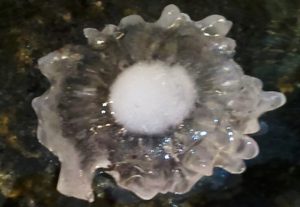Hail is precipitation in the form of balls or chunks of ice.
Hailstones begin as small ice particles that grow primarily by accretion; to grow large, they require abundant water droplets. As the hailstone moves up and down through a storm, it collides with water droplets and ice crystals, growing larger with each collision. Hailstones can be smaller than peas or as large as oranges and grapefruits. The small hailstones are roughly spherical in shape, while large ones can take on jagged shapes.
When a hailstone is cut in half, you can see rings of ice. Some rings are milky white; others are clear. This ringed structure indicates that hailstones grow by two different processes: wet growth, represented by the clear layers, and dry growth, which forms the milky white layers. Counting the layers of clear and milky white ice gives an indication of how many times the hailstone traveled through the storm.
Dry growth of hailstones occurs when the air temperature is well below freezing. In these conditions a water droplet freezes immediately as it collides with the hailstone. This quick freezing leads to air bubbles “frozen” in place, leaving cloudy ice.
In wet growth, the hailstone is in a region of the storm where the air temperature is below freezing but not very cold. When the hailstone collides with a drop of water, the water does not freeze on the ice immediately. Instead, the liquid water spreads over the hailstones and slowly freezes. Because the water freezes slowly, air bubbles can escape, resulting in a layer of clear ice.
With wet hail growth, a thin layer of liquid water can remain on the surface of a hailstone. This thin layer helps hailstones that collide to freeze to each other, forming jagged shapes.
Steve Ackerman and Jonathan Martin, professors in the UWM Adison department of atmospheric and oceanic sciences, are guests on WHA radio (970 AM) at 11:45 a.m. the last Monday of each month. send them your questions at stevea@ssec. wisc.edu or jemarti1@wisc.edu.


